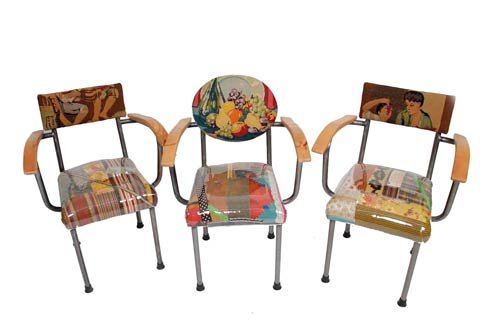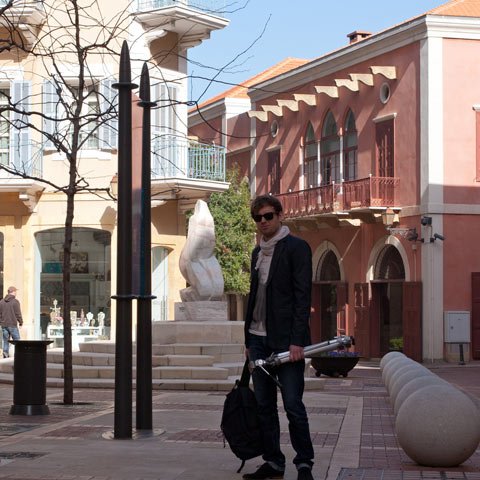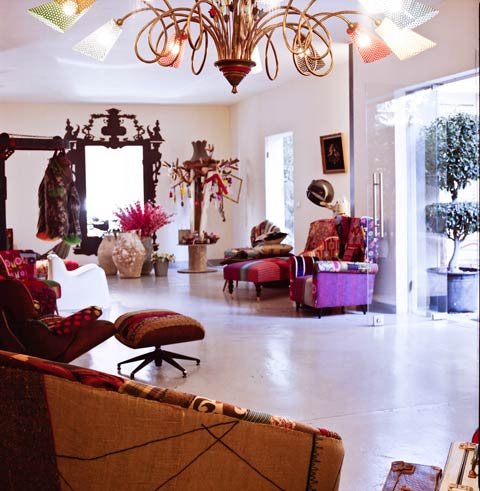This spring I had the pleasurable honour to meet up with the esteemed women behind the Bokja creations in Beirut. Hoda Baroudi and Maria Hibri agreed to share some of their experiences and stories behind their work and how they feel designing in the crossroads of multiple cultures.
I feel that in Lebanon stories are somehow intensified. I often hear people saying the country is fractured through the mix of cultures, to me its more like French cuisine were you get a mouthful flavours and all are really distinguished. I like to think of it in that way, how do you feel about this?
Maria Hibri
I like how you describe it. You know we always say Bokja is intimately linked to Beirut. We are very tuned to what is happening around us here, it is such an intense place. Beirut is not a normal place to be, everything happens every day and you live the moment (snap) like that and this shows itself in our designs. This is Bokja, this is what we do.
What does Bokja mean?
Maria Hibri
Bokja is the wrap were you put the dowry of the bride. It is something that is commonly used in different languages, but they always call it Bokja in all the Arab world. When the bride gets married, this is the day she is born actually, the women in the family start embroidering her dowry, and when she leaves home to go to her new life she puts all those hand-embroidered things made with love in that Bokja. They coul d put in bed sheets, linens, or anything prepared for you.

You could say it is a memory cell of the previous life?
Maria Hibri
Yes, exactly. It also accompanies every aspect of her life from child bearing to marriage to even death. All the things that would accompany her will be in that Bokja.
Our story is a story of women, we are two women and we work mostly with these handmade, hand-embroidered textiles. We mostly even work with women. When we get our textiles, we buy them from women.

Does this have some background in you, is this a choice due to some of your previous experiences? Is it part of your story?
Maria Hibri
In my family there was a lot of respect towards everything handmade or hand-embroidered. My grandmother used to make little things for us, she would embroider pillows and little napkins. It was something that we cherished, we respected anything that was not machine made, things with feelings. So many thoughts come to your mind when you are doing these embroideries, you can see that the fabric is different from any other, it is not flat, it has stories to tell and it transcends through time. We didn’t want to waste or forget any of these stories and so we started to do this assemblage made of little pieces. We wanted to honour the thoughts that had gone into each piece and through this we started what we are best know for, the Bokja assemblage.
How do you see this action of combining the past stories of the textiles with your craft projects onto the objects you create?
Maria Hibri
Initially the concept of Bokja was to re-invent our tradition, to breath a new life into it. So we use traditional textiles that are now disregarded and thought to be old fashioned. They have become invisible to us, we don’t see them anymore. This is why we try to present them in a contemporary way, so they would be once again appealing to the eyes, be more edgy. We hope this would make young people more sensitive to the textiles and they would try to honour our tradition in this way.
If I were to give my daughter some things that I’ve collected from my mother and grandmother she would consider them simply weird, but by posting them on an Eames lounge chair they become sexy. Presented like this she would definitely want these objects, she would try to have them.
You cannot forget your past and you have to really try to understand it and honour it. We have to move on and moving on is just to adapt. Geographically Lebanon is a recipient of many cultures, there is a richness here. But few people understand the meaning of Lebanon and how it is unless they come here, they will see how the east is open to the west, or actually, how it is arms wide open to the west. Somehow in this country we were able to make the best of both and this is why it is so attractive nowadays, and if we have peace it will be even more attractive.

You said that each object has its own story, does this give objects different roles or even a character?
Maria Hibri
It is funny that you are asking this because each Bokja has a passport. It is a copy of the Lebanese passport with birds instead of the Cedars on it. Inside we write the date of birth, the nationality for each chair. For us it is a thing out of this world. It is made in Lebanon but it addresses itself to the whole world, with the passport it is saying that there are no boundaries. We believe in the dialogue between cultures.
In the Salone del Mobile last year in Milan we presented two sofas that we made using fabrics from 30 different origins. We used fabrics from Italy, fram Margiela, from a skirt that used to belong to Hoda and put these next to a fabric from Afghanistan, Palestine, Brazil, Africa… Next to the sofa we put little swatches of each fabric with a our personal story of how we came upon these fabrics. Our message was to say that although the fabrics come from different origins, they speak a common language when it comes to beauty, aesthetics, but not necessarily only beauty, it could be an unexpected harmony of something that is not supposed to work together.
How do you feel the user can benefit from having these multiple backgrounds or stories within the object?
Hoda Baroudi
Anyone who would buy a piece from Bokja, we have many kinds of clients, but we prefer the kind who is already knowledgeable about what he is buying, so mostly we like to sell to people who know about the textiles, who know about the history and when they take this piece they take with them a slash of the culture of the pieces that are available there. I mean this sofa talks to you about many things it talks to you about a certain mood of the guy who embroidered it in central Asia, of the colours. Because of the desert in that land he used colours to compensate for the lack of flowers and for the aridity of the land.
Maria Hibri
People always say that a Bokja piece in the house has positive energy, maybe because of the unique approach and it is also like a smile in the house. We like to say that our things when they travel they go to tell our story in a way. This is why we are very keen for people to know what the ingredients in the chair or sofa are. In the passport of each chair we write a description with a list of the origins of each fabric used in the piece. It is very important for the people when they have the chair to know what they have between their hands, so it is not just another piece of furniture for them.

This surely creates an appreciation, knowing the origin, the story of the object you own?
Maria Hibri
Yes, our design process is not just about designing and being able to sell, we have a definite message that we are trying to say through what we do, and we like people to really be tuned to it.
Hoda Baroudi
Many people during our first years of business bought our products, sometimes we think, for the wrong reasons, for that added colour in their houses. Many in the Arab countries live in the deserts and they love those strong colours. As our work became more complex, as we were adding layers and layers of textiles, meaning layers and layers of cultures in that same piece, more and more we were attracting an informative clientele. A clientele from Europe, especially Germans, they love what we do, because Germans are very sensitive about traditional textiles.
How do you see your stories to evolve? What would be your next step forwards?
Hoda Baroudi
Maria told you about the exhibition we held in Milano last year, the two sofas with fabrics from 30 different origins. We wanted in a way to sort of say this is ten years of work, ten years of Bokja that sort of culminates in those two sofas. Ever since we are trying to make our work, if you want, more “abstract”. We want to continue the idea, we want to continue the message, and taking the essence and applying it elsewhere. We are working with this kind of condensed wool that is recycled and applying bits and pieces of textiles. It is becoming more the gist of Bokja than the layering of textiles as they are.
Maria Hibri
We are trying to invent a new word, which is to Bokjadize things. So we look at objects around us and we do the exercise; how can we Bokjadize this? We found out that it is possible, not only through textiles, in a way Bokja has become a certain way of seeing things and doing things. By being ethically conscious and trying always to be resourceful and have more fun.
Hoda Baroudi
Are you familiar with Lidewij Edelkoort? She is the director of Eindhoven School of Design. She is for many people the lady of design in the world, she is the lady who put Holland on the map, in terms of attracting people to Eindhoven. After that she started a company called Trend Forecasting this company tries to forecast the coming 10-20 years. She has regular exhibitions in Paris, in Amsterdam, all over Europe, in New York she does lectures. She did this exhibition and she saw our work in Miami in 2008 while she was planning for an exhibition called Archaeology of the Future in Paris. For this exhibition she argued that design doesn’t come out of nothing, design is always steeped in history. You cannot say that I have this idea, it is avant-gardist, it has no roots. Always a design has to be rooted in history. For her Bokja is a perfect example of that, because not only do we take the historical story and we re-invent it, and what makes it special for her is the attention we create between the traditional textile and the modernity of the piece of furniture that we use it on.
How do you feel you as a designer reflect your story in the things you create?
Hoda Baroudi
We did an interesting lecture in Lausanne last year and we brainstormed the issue on how best to present our work. We came to the conclusion that mostly our work is a reflection of us. Who are we? We are two women from Beirut, so in the end Bokja is a reflection of this city. You have a lot of contradiction in it, and you have a lot of worldly influences and you have a lot of contemporary feed, and this makes it beautiful. To the excel that we called one of the chairs we created schizophrenia to reflect the schizophrenic mood of the city in many instances.
Maria Hibri
We have years and years of influences, over time the shores were receptive to many civilizations. You have layers of civilizations from all over the world and this is what I think you see at Bokja.
You talked earlier that you want the object to give a smile to the people. Which one is the one that gives you a smile?
Maria Hibri
Don’t you have a smile when you see this sofa.
Hoda Baroudi
Or the schizophrenia.

Hoda Baroudi
This is the schizophrenia chair. We put the plastic because for us it was a twist on the taxis. The old taxi service in Beirut in the 60s, they always used to protect their sofas in the car by putting plastic. Once we sold a sofa to a hairdresser in Saudi Arabia and he put a big sofa in the saloon and he put nylon on it to protect it from the water. So it was a funny take on this old habit.





One thought on “Interview with Bokja”
Comments are closed.